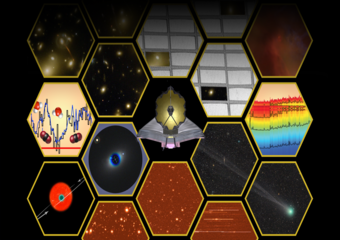
"Campus, Silicon Valley leaders celebrate Lick Observatory’s 130th anniversary "
- July 24, 2018
UC Santa Cruz and Silicon Valley leaders on Monday marked the 130th anniversary of Lick Observatory, which has been at the forefront of astronomical research since 1888.

In Search of Dark Matter
- July 12, 2018
Researchers, including a UC Riverside particle physicist, interpret new experimental data aimed at showing dark matter interacts with ordinary matter — an unmet challenge in modern physics.

ISEE receives presidential award for excellence in STEM mentoring
- June 26, 2018
The award, established by the White House in 1995, recognizes mentors working to ensure that tomorrow's scientists and engineers will better represent the nation's diverse population. The award honors people and programs that have demonstrated excellence in mentoring individuals from groups that are underrepresented in STEM education and the workforce.

Dust clouds can explain puzzling features of active galactic nuclei
- June 14, 2018
Mysterious features seen in light emitted from active galactic nuclei may be due to partial obscuration by dust clouds, according to new study.

More Mystery Objects Detected Near Milky Way’s Supermassive Black Hole
- June 6, 2018
Astronomers have discovered several bizarre objects at the Galactic Center that are concealing their true identity behind a smoke screen of dust; they look like gas clouds, but behave like stars.

New model explains what we see when a massive black hole devours a star
- May 29, 2018
A star that wanders too close to the supermassive black hole in the center of its galaxy will be torn apart by the black hole's gravity in a violent cataclysm called a tidal disruption event (TDE), producing a bright flare of radiation. A new study led by theoretical astrophysicists at the University of Copenhagen's Niels Bohr Institute and UC Santa Cruz provides a unified model that explains recent observations of these extreme events.

Distant Moons May Harbor Life
- May 30, 2018
In a paper forthcoming in The Astrophysical Journal, researchers at the University of California, Riverside and the University of Southern Queensland have identified more than 100 giant planets that potentially host moons capable of supporting life. Their work will guide the design of future telescopes that can detect these potential moons and look for tell-tale signs of life, called biosignatures, in their atmospheres.

U.S. national observatory and two extremely large telescope projects team up
- May 21, 2018
A new research frontier in astronomy and astrophysics will open in the mid-2020s with the advent of ground-based extremely large optical-infrared telescopes (ELTs) with primary mirrors in the 20-m – 40-m range. U.S. scientific leadership in astronomy and astrophysics will be significantly enhanced if the broad U.S. community can take advantage of the power of these new ELTs.

Face recognition for galaxies: Artificial intelligence brings new tools to astronomy
- April 23, 2018
A machine learning method called "deep learning," which has been widely used in face recognition and other image- and speech-recognition applications, has shown promise in helping astronomers analyze images of galaxies and understand how they form and evolve.

Credit: V. Buso, M. Bersten, et al.
Amateur astronomer captures rare first light from massive exploding star
- February 21, 2018
Image caption: Sequence of combined images (negatives, so black corresponds to bright) obtained by Víctor Buso as SN 2016gkg appears and brightens in the outskirts of the spiral galaxy NGC 613. Labels indicate the time each image was taken. The object steadily brightens for about 25 minutes, as shown quantitatively in the lower-right panel.

Supermassive black holes control star formation in large galaxies
- January 1, 2018
Young galaxies blaze with bright new stars forming at a rapid rate, but star formation eventually shuts down as a galaxy evolves. A new study, published January 1, 2018, in Nature, shows that the mass of the black hole in the center of the galaxy determines how soon this "quenching" of star formation occurs.

NASA's James Webb Space Telescope Early Science Observations Revealed
- November 13, 2017
Astronomers around the world will have immediate access to early data from specific science observations from NASA’s James Webb Space Telescope, which will be completed within the first five months of Webb’s science operations.

Illustration by Robin Dienel courtesy of the Carnegie Institution for Science
UC astronomers first to observe merging neutron stars
- October 16, 2017
A small team of UC Santa Cruz astronomers led by UCSC Asst. Prof. Ryan Foley observed the first visible event ever linked to gravitational waves on August 17th, 2017. Foley's team captured the first images of the event, located in a galaxy 130 million light-years away called NGC 4993, with the 1-meter Swope Telescope at the Carnegie Institution's Las Campanas Observatory in Chile.

Photo by Tim Stephens
New mirror-coating technology promises dramatic improvements in telescopes
- September 18, 2017
At UC Santa Cruz, an electrical engineer has teamed up with astronomers to improve telescope mirrors using thin-film technology from the electronics industry.

TMT Workshop (Photo by Carolyn Lagattuta)
UC Santa Cruz hosts international workshop for Thirty Meter Telescope
- September 1, 2017
Workshop participants, representing all of the TMT International Observatory's partners (Canada, China, India, Japan, UC, and Caltech), worked on projects in small teams, visited astronomical laboratory facilities, toured Lick Observatory, and met with numerous scientists and engineers involved in TMT.

Jerry Nelson
Tributes to Jerry Nelson (1944 - 2017)
- June 14, 2017
Jerry Nelson was an American astronomer known for his pioneering work designing segmented mirror telescopes. He was the principal designer and project scientist for the Keck telescopes.
Media Information
Ilse Ungeheuer, Communications Manager
iungeheuer@ucolick.org
